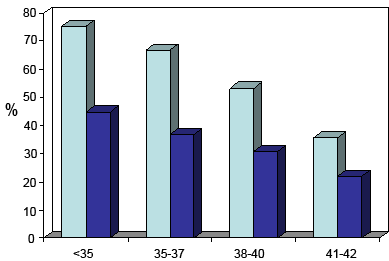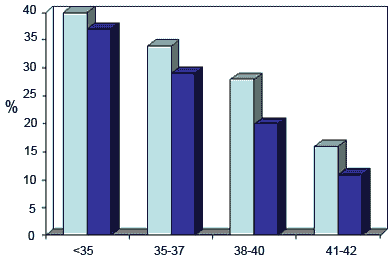Tubal Reversal Study Report 2009
Notice of Study Update
The following is Dr. Berger’s report from 2009. The an updated report can be seen at:
Tubal Reversal Pregnancy Study Report 2011.
Pregnancy And Birth Rates: Tubal Reversal vs. IVF
Women who want to get pregnant after a tubal ligation have two treatment options: tubal ligation reversal or in vitro fertilization (IVF). To compare the success of these two treatments, the tubal reversal pregnancy statistics from Chapel Hill Tubal Reversal Center can be compared with the latest available national IVF statistics (National Summary and Fertility Clinic Reports).
During 2006 in the United States, 99,199 IVF cycles using fresh non-donor eggs or embryos were begun. Of these, 34,719 (35%) resulted in pregnancy and 28,404 (29%) resulted in live birth deliveries. Pregnancy rates after tubal reversal and after IVF were compared based on the age categories reported in the National Summary and Fertility Clinic Reports (Figure 3). The pregnancy rate after tubal reversal was higher than after IVF within every age group.
Figure 3. Pregnancy Rates After Tubal Reversal vs IVF
![]() IVF
IVF

Age
Similarly, birth rates were higher after tubal reversal at Chapel Hill Tubal Reversal Center than after IVF for women of all ages and the differences increased with increasing maternal age (Figure 4).
Figure 4. Birth Rates After Tubal Reversal vs IVF
![]() IVF
IVF

Age
Comparing Tubal Reversal and IVF
Tubal reversal surgery differs from IVF in significant ways. The chances of getting pregnant after tubal reversal continue each month following the surgery. The pregnancy rate after tubal reversal, therefore, continues to increase over time and more than one pregnancy and birth can result from a sterilization reversal procedure. With treatment by IVF, the outcome is immediate. If pregnancy does not occur, then a couple must decide whether or not to go through the treatment process again. Since the chances of getting pregnant after tubal reversal are cumulative over time, this procedure results in higher pregnancy and birth rates than after an IVF cycle.
Tubal Reversal Pregnancy Study Report 2009
Table Of Contents:
-
- Overview
- Study Method
- Patient Population – US States
- Patient Population – Age and Tubal Ligation Procedures
- Pregnancy Rates by Age and Method
- Pregnancy Rates by Tubal Length
- Pregnancy Outcomes
- Comparison Of Tubal Reversal vs. IVF (this page)
- About Pregnancy Statistics








